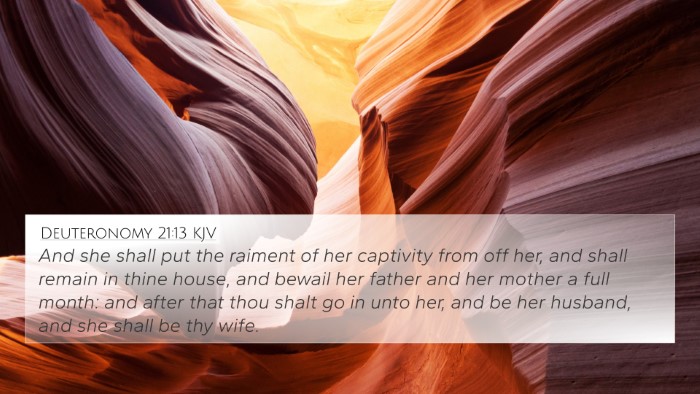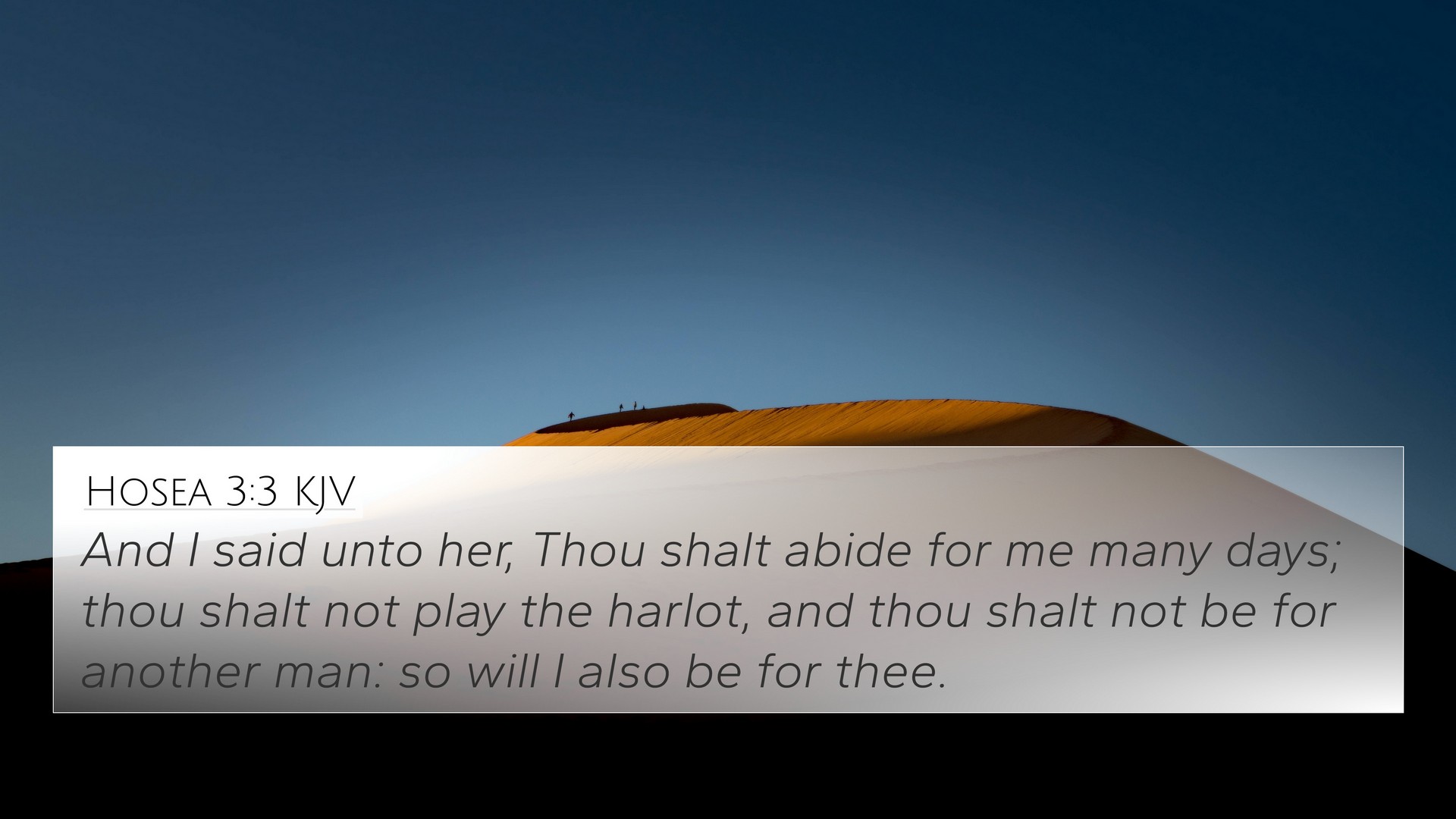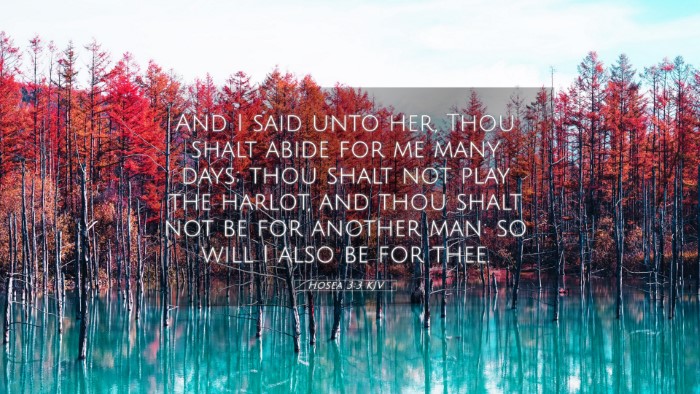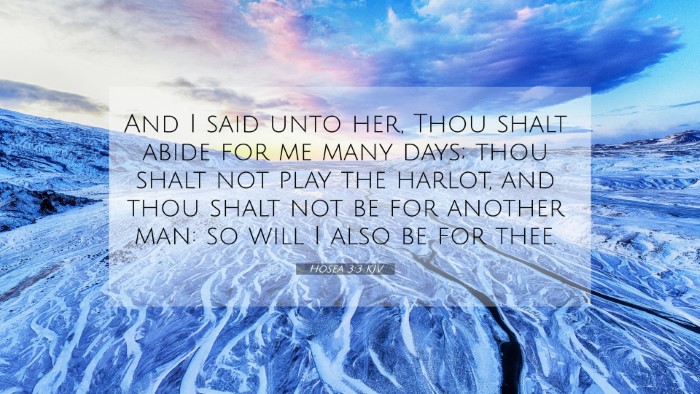Old Testament
Genesis Exodus Leviticus Numbers Deuteronomy Joshua Judges Ruth 1 Samuel 2 Samuel 1 Kings 2 Kings 1 Chronicles 2 Chronicles Ezra Nehemiah Esther Job Psalms Proverbs Ecclesiastes Song of Solomon Isaiah Jeremiah Lamentations Ezekiel Daniel Hosea Joel Amos Obadiah Jonah Micah Nahum Habakkuk Zephaniah Haggai Zechariah MalachiHosea 3:3 Similar Verses
Hosea 3:3 Cross References
And I said unto her, Thou shalt abide for me many days; thou shalt not play the harlot, and thou shalt not be for another man: so will I also be for thee.
Uncover the Rich Themes and Topics of This Bible Verse
Listed below are the Bible themes associated with Hosea 3:3. We invite you to explore each theme to gain deeper insights into the Scriptures.
Hosea 3:3 Cross Reference Verses
This section features a detailed cross-reference designed to enrich your understanding of the Scriptures. Below, you will find carefully selected verses that echo the themes and teachings related to Hosea 3:3 KJV. Click on any image to explore detailed analyses of related Bible verses and uncover deeper theological insights.

Deuteronomy 21:13 (KJV) »
And she shall put the raiment of her captivity from off her, and shall remain in thine house, and bewail her father and her mother a full month: and after that thou shalt go in unto her, and be her husband, and she shall be thy wife.
Hosea 3:3 Verse Analysis and Similar Verses
Understanding Hosea 3:3
Hosea 3:3 is a profound verse that encapsulates themes of love, redemption, and restoration. This verse highlights the relationship between God and Israel, displaying the depths of divine love and the call for faithfulness. Below is a detailed summary of the meaning of this verse as interpreted by notable public domain commentaries such as Matthew Henry, Albert Barnes, and Adam Clarke.
Verse Context
Hosea 3:3 states:
"And I said unto her, Thou shalt abide for me many days; thou shalt not play the harlot, and thou shalt not be for another man: so will I also be for thee." (Hosea 3:3)
Summary of Meaning
This verse is situated within the larger narrative of the Book of Hosea, where the prophet’s personal life serves as a metaphor for God's relationship with Israel. Hosea's marriage to Gomer, a woman characterized by unfaithfulness, mirrors Israel's infidelity to God. In this verse, Hosea's instruction to Gomer reveals an important theological and relational dynamic:
-
Divine Commitment:
Hosea's words reflect a commitment to Gomer, signifying God's unyielding love for Israel despite their unfaithfulness. Matthew Henry notes that this is a picture of God's eternal betrothal to Israel, emphasizing that, like Hosea, God remains steadfast in His love.
-
Call to Repentance:
The directive for Gomer not to engage with other men represents God's call for Israel to turn away from idol worship and return to the covenant relationship. Albert Barnes elaborates that this reflects God’s desire for His people to genuinely repent and seek restoration.
-
Promise of Restoration:
Hosea vows to be for Gomer, implying a future reconciliation. Adam Clarke indicates that this correlates with the prophetic promise of Israel’s ultimate restoration, paralleling the New Testament hope in Christ.
Key Themes and Connections
Hosea 3:3 encapsulates several key themes, which are interwoven with other scriptural passages:
- Faithfulness in Relationships: This verse echoes Christ’s teachings on marital fidelity in Matthew 19:4-6, where the sanctity of the marriage covenant is highlighted.
- Divine Love: Similar to the proclamation in Romans 5:8, which states God shows His love by dying for us while we were still sinners, reflecting the depth of God’s commitment and love.
- Repentance and Redemption: The call for Gomer to remain faithful can be parallel to 2 Chronicles 7:14, emphasizing the necessity of turning back to God for healing and restoration.
- Covenantal Relationship: The theme of covenant is central to this verse, relating to Jeremiah 31:31-34, where God promises a new covenant characterized by internal transformation and faithfulness.
- Restoration after Unfaithfulness: This is seen in Isaiah 54:5-8, which describes God as a Redeemer and Husband who restores His people after a period of separation.
- Identity of God's People: 1 Peter 2:9 speaks of how believers are a chosen generation, underscoring that identity comes from God's choice and commitment.
- Faithfulness of God: The essence of God's unwavering love and faithfulness reverberates through Lamentations 3:22-23, reminding us that His mercies are new every morning.
Bible Cross-References
In exploring the insights of Hosea 3:3, several cross-references enrich the understanding of its themes:
- Jeremiah 3:1 - Discusses the attribute of a faithful husband.
- Hosea 14:4 - God promises to heal Israel's backsliding and love freely.
- Ephesians 5:25-27 - Christ’s love for the church paralleled with Hosea's commitment to Gomer.
- Revelation 21:2 - The notion of God’s ultimate union with His people is seen in the New Jerusalem.
- Matthew 12:39 - Reflecting on the fickle hearts of people as seen through biblical narratives of unfaithfulness.
- Isaiah 49:15 - God’s unwavering support and reach out to His people despite their unfaithfulness.
- John 10:14 - Jesus as the good shepherd, paralleling Hosea’s role as a loving husband.
Conclusion
Hosea 3:3 serves as a powerful reminder of God's relentless pursuit of humanity despite our failures. The intertwining themes of love, faithfulness, and redemption found in this verse resonate throughout the Bible, demonstrating a continuity of divine intent and relational integrity. This verse not only stands alone but invites readers to explore its vast and rich connections to numerous scriptures found throughout the Bible.
For those studying the Bible deeply, using cross-reference tools and guides can deepen understanding and reveal the connections between these verses, enhancing both personal faith and biblical literacy.


